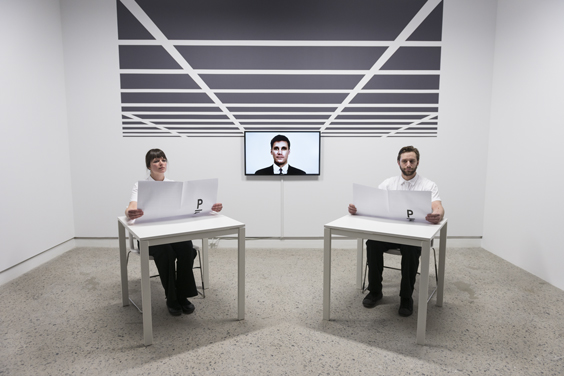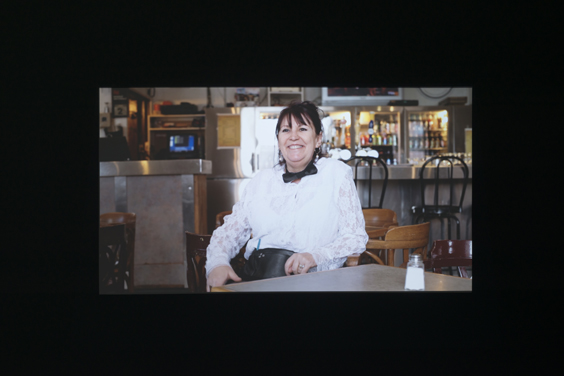[français]
18 April – 13 June 2015
Optica, Montréal
Curated by Véronique Leblanc
Artists: Anne-Marie Ouellet, Emmanuelle Léonard, Katarina Zdjelar, Kaya Behkalam & Azin Feizabadi, Sophie Castonguay, Dave Ball & Oliver Walker
Polyphonies is an exhibition that stages a plurality of voices while bringing together the work of eight artists including two duos. Whether based on documentary approaches (interviews, surveys) resembling anthropological field studies or revolving around the invention of fictional situations in which archives of various kinds are played out, the orchestration of speech in the artists’ propositions creates a disjunctive gap with the documented reality. They appropriate ways of telling stories (in past, present, and future tenses) to bring out issues in the ideological and identity-related constructions that take shape through speech.
The performative installation project Penser le futur (2013-2015) developed by Anne-Marie Ouellet (Québec) rearranges the results of a survey conducted among 187 people about their general views on the future. By manipulating the responses given her, Ouellet interrogates the mechanics of polarization and normalization that take effect in manufacturing public opinion.
Produced in collaboration with a small group of the regulars and personnel of a neighborhood bar, Québec artist Emmanuelle Léonard’s La taverne (2015) features a succession of individuals addressing the camera. Their preoccupations and opinions inscribe the expression of personal experience into the social life of the milieu while situating the protagonists between marginality and the stereotypical.
In the video Don’t do it Wrong (2007), Katarina Zdjelar (Serbia/the Netherlands) examines the moment during which, every morning, schoolchildren sing the national anthem at the beginning of the day in an Istanbul primary school. While the pupils’ arrangement in rows suggests a “collective body†in which the individual is at one with the nation, the children’s behaviour is constantly fracturing the unity that is being imposed upon them.
The video installation The Negociation (2010), jointly produced by Kaya Behkalam (Germany/Egypt) and Azin Feizabadi (Iran/Germany), observes the conflictual relationships that develop between members of a group discussing their conceptions of revolution. In a dual projection, the actors’ voices alternate with the voice of a narrator while also interacting with visual and textual elements that influence the discussion. In a kind of narrative stratification, this work examines representation, the reinterpretation of recent history, and the development of an imaginative world.
With La part du lion (2015), Sophie Castonguay (Québec) convenes spectators to an unfolding, multivalent discourse set before a series of paintings created by her peers. Performed by a reciter and asserting the role of language in the very act of perception, the work places the visitor in a zone of uncertainty between a painted and a projected image, between the visible and the sayable, in short, between that which is present and the meaning created in a given situation.
Dinner Party (2011-2015), a participatory project by Dave Ball and Oliver Walker (United Kingdom/Germany), calls upon eight characters who’ve never met and who accept to take part in a “mediatized†discussion around a meal served by the artists. Four of the guests, concealed in various rooms, use phones and earpieces to animate the discussion of the other four, who are seated at the table in main room. Recreated in Montréal, April 15 to 22, 2015, the experience interrupts the usual modes of socialization by decoupling verbal and non-verbal forms of communication.
Built as polyphonic structures or using polyphony as a method, the works in the exhibition sound out the complexity of relationships between individuality and community. Each of the works establishes a discursive space in which personal conviction, belief, and individual experience encounter social and institutional spheres. From standardization to dissent, from subjection to self-determination, and especially in the constant negotiation between these extremes, the works all refer to the makeup of public and political spaces and to the conditions of possibility for living-together.
In accord with their polyphonic dimension, the exhibition proposes to envisage these works as so many “voices†from distinct social, political, and historical contexts, reverberating in one another and resonating with shared, more global preoccupations. Concerned with notions of belonging, difference, representation, normativity, and common, they interrogate the power relationships that are established through language, along with the process by which identity-related and ideological constructs take part in articulating shared life and experience.
Véronique Leblanc
Véronique Leblanc is an independent curator, and an art history lecturer at Université du Québec à Montréal. She is interested in the generation of contradictions and uncertainty as an artistic strategy.
Optica
5445 avenue de Gaspé, #106, Montréal (Qc) Canada H2T 3B2
www.optica.ca
Tuesday – Saturday: 12h00 – 17h00
18 avril – 13 juin 2015
Optica, Montréal
Commissaire : Véronique Leblanc
Artistes : Anne-Marie Ouellet, Emmanuelle Léonard, Katarina Zdjelar, Kaya Behkalam & Azin Feizabadi, Sophie Castonguay, Dave Ball & Oliver Walker
L’exposition Polyphonies réunit les œuvres de huit artistes, incluant deux duos, qui mettent en scène une pluralité de voix. Tantôt fondées sur des approches documentaires qui s’apparentent à l’exercice du terrain anthropologique (entrevue, questionnaire), tantôt axées sur l’invention de situations fictionnelles à l’intérieur desquelles on rejoue différentes formes d’archives, ces œuvres orchestrent la parole de façon à ce que les propositions des artistes créent un écart avec la réalité documentée. Elles s’approprient des manières de se raconter (au passé, au présent et au futur) pour problématiser les constructions identitaires et idéologiques qui prennent forme dans l’usage de la parole.
Le projet d’installation performative Penser le futur (2013-2015) élaboré par Anne-Marie Ouellet (Québec) procède à une réorganisation des résultats obtenus dans le cadre d’un sondage effectué auprès de 187 personnes portant sur les perceptions générales du futur. En manipulant les réponses qui lui ont été données, elle interroge les mécanismes de polarisation et de normativité qui agissent dans la fabrication de l’opinion publique.
Réalisé avec la collaboration d’un petit groupe de clients réguliers et d’employés d’un bar de quartier, La Taverne (2015) d’Emmanuelle Léonard (Québec) montre une succession d’individus s’adressant à la caméra. Les préoccupations et les convictions exprimées par les protagonistes inscrivent l’expression de l’expérience personnelle dans la vie sociale de l’endroit en même temps qu’elle situe les individus entre marginalité et stéréotype.
Dans la vidéo Don’t do it Wrong (2007), Katarina Zdjelar (Serbie / Pays-Bas) pose un regard sur le moment où, chaque matin, les élèves d’une école primaire d’Istanbul chantent l’hymne national à l’entrée des classes. Alors que la formation des élèves en rangs évoque un « corps collectif » au sein duquel l’individu fait un avec la nation, le comportement des enfants contrevient sans cesse à l’unité qu’on tente de leur imposer.
L’installation vidéo The Negociation (2010), réalisée en duo par Kaya Behkalam (Allemagne / Égypte) et Azin Feizabadi (Iran / Allemagne), observe les rapports conflictuels qui s’instaurent entre les individus d’un groupe débattant de leur conception de la révolution. Dans une double projection, les voix des acteurs alternent avec celle d’un narrateur en plus de s’amalgamer à des éléments visuels et textuels qui infléchissent le discours. C’est par une sorte de stratification narrative que cette œuvre traite de représentation, de réinterprétation de l’histoire récente et d’élaboration de l’imaginaire.
Avec La part du lion (2015), Sophie Castonguay (Québec) convie le spectateur au déploiement d’un discours polysémique devant un ensemble de tableaux créés par ses pairs. Affirmant le rôle du langage dans l’acte même de percevoir, l’œuvre performée par un récitant place le visiteur dans une zone d’incertitude entre l’image peinte et l’image projetée, le visible et le dicible, bref, entre ce qui est là et le sens à fabriquer dans une situation donnée.
Le projet participatif Dinner Party (2011-2015) de Dave Ball et Oliver Walker (Royaume-Uni / Allemagne) fait appel à huit personnes ne s’étant jamais rencontrées et acceptant de se prêter au jeu d’une discussion « médiatisée » autour d’un repas servi par les artistes. Quatre des convives sont dissimulés dans des pièces différentes et sont chargés d’animer la discussion de quatre autres invités assis à la table de la pièce centrale à l’aide de téléphones et d’écouteurs. Réactualisée à Montréal du 15 au 22 avril 2015, cette expérience interrompt les modes de socialité habituels en dissociant communication verbale et non-verbale.
Construites selon des structures polyphoniques ou utilisant la polyphonie comme méthode, les œuvres de l’exposition sondent la complexité des rapports entre individualité et collectivité. Chacune des œuvres met en place un espace discursif dans lequel la conviction intime, l’expérience individuelle et la croyance rencontrent les sphères sociale et institutionnelle. De la normativité à la dissension, de l’assujettissement à l’autodétermination et surtout dans la négociation constante entre ces extrêmes, l’ensemble des œuvres se rapporte à la constitution d’espaces publics et politiques ainsi qu’aux conditions de possibilités du vivre-ensemble.
En accord avec la dimension polyphonique des œuvres, l’exposition propose d’envisager les œuvres comme autant de « voix » issues de contextes sociaux, politiques et historiques distincts, trouvant des échos les unes dans les autres et résonnant avec des préoccupations partagées à une échelle plus globale. En s’intéressant aux notions d’appartenance, de différence, de représentation, de normativité et de commun, elles problématisent les relations de pouvoir qui s’instaurent dans l’utilisation du langage et interrogent les processus par lesquels les constructions identitaires et idéologiques participent à l’articulation de la vie commune.
Véronique Leblanc
Véronique Leblanc est commissaire indépendante et chargée de cours en histoire de l’art à l’Université du Québec à Montréal. Elle s’intéresse à la production de la contradic- tion et de l’incertitude comme stratégie artistique.
Optica
5445 avenue de Gaspé, #106, Montréal (Qc) Canada H2T 3B2
www.optica.ca
mardi – samedi : 12h00 – 17h00


